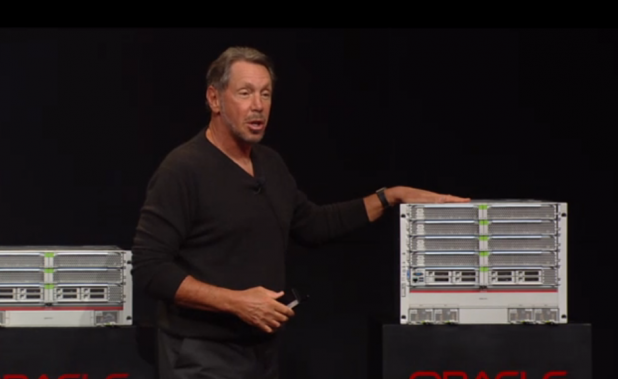Oracle has whipped the curtain back from what it claims is the "world's fastest microprocessor"—and it may not be the one that everyone was expecting. Oracle launched the SPARC T5 microprocessor at a March 26 event, accompanied by three midrange servers with two, four, and eight sockets. If that wasn’t enough, the company also announced a second microprocessor, the SPARC M5, with mainframe-class support for 16 and 32 sockets. (The existing SPARC T4 line will remain as Oracle's low-cost offering.) "When Oracle bought Sun, the thought was that the SPARC processor was a real laggard; they believed that we could never catch up," Oracle CEO Larry Ellison said at a press conference. "We did better than catch up; we caught up and passed the competition." And the future, executives said, was on-chip Java and database acceleration, which would improve the SPARC architecture's performance still further.
The Specs
Compared to the SPARC T4, the T5 offers double the cores, threads, and cache, as well as 2.5 times the memory bandwidth. The systems offer five times the application performance of the previous systems, along with five times the memory bandwidth, twice the memory capacity, and four times the I/O bandwidth. Ellison also claimed that the T5 series offered three times the application performance of IBM's POWER line, twice the cores, four times the threads, and twice the memory bandwidth. Specifically, the T5 series includes 128 cores and 1,024 threads; up to 4 TBs of memory; and a terabyte per second of memory bandwidth. It includes 1.2 TB/s of system bandwidth, 256 GB/s of I/O bandwidth, and 3.2 million IOPS. The M5 includes 192 cores and 1,536 threads; up to 32 TBs of memory; and 1.4 TB/s of memory bandwidth. It also features 3 TB/s of system bandwidth and 1 TB/s of I/O bandwidth. Oracle did not quote an IOPS number. Oracle did not really disclose system pricing for all of its new servers; the T5-8, "loaded with memory," Ellison said, will cost $620,000. Ellison and systems chief John Fowler showed off a range of benchmarks designed to pummel IBM's competing POWER series, including what the Oracle CEO called 32 "world records.” Oracle released benchmarks showing that a single $600,000 T5-8 could deliver the same database performance as three clustered IBM Power 780s, and the same Java middleware performance versus an IBM P780 (which was 12 times more expensive). In integer performance measured by the Specint_rate2006 benchmark, the T5-8 delivered a score of 3,750, Oracle said, versus 2,770 for the IBM P780. Other real-world applications tests with an undisclosed financial data company showed a 1.4X-transactions-per-second improvement with eightfold cost savings.
Retort
According to Oracle’s competition,
the TPC-C results released on the morning of March 26, as well as a
corresponding SAP benchmark, were disappointing. Oracle reported a tpmc benchmark of 8,552,523 for a server specced at $4.66 million, or 55 cents per tpmc. "The IBM POWER7+ with DB2 10 result from back in September was 1.3x greater per core than the M5 and 1.9x greater than the T5 result," Elisabeth Stahl, chief technical strategist for IBM,
wrote in a post taking aim at Oracle's SAP benchmarks. "The IBM average database request time was also much better and the CPU utilization of the IBM system was also more effective." Stahl also claimed that the TPC numbers were "lackluster.” However, the numbers she cited also included $/tpmc numbers that were slightly higher than five times what Oracle reported—a cost argument that Oracle made time and again during its presentation. The server that Oracle used for the TPC-C results included a 3.6-GHz SPARC T5 chip with 8 processors, 128 cores, and 1,024 threads. That's in line with what Oracle claimed at its Hot Chips presentation in August, when it (naturally) asserted that the T5 would be the best, highest-performance processor to accelerate Oracle's own databases. Ellison said his company hadn't yet reported a TPC score for its M-series systems, but it would.
“We’re the Only Ones”
Intriguingly, Ellison also said that its "2014 microprocessor," presumably the SPARC T6, would include hardware acceleration for databases and Java processing. That would take the concept of on-chip hardware coprocessors, used today for encryption, and apply them to accelerating Oracle's own databases. As Oracle moves databases from disk drives to flash and then to main memory, companies will have to make significant improvements for how they craft microprocessors, Ellison said. "We've never done this for databases, and we're going to do it for Java, and as far as we know we're the only ones that are going to do it, and that will allow us to double performance again and again," Ellison said.
Image: Oracle 